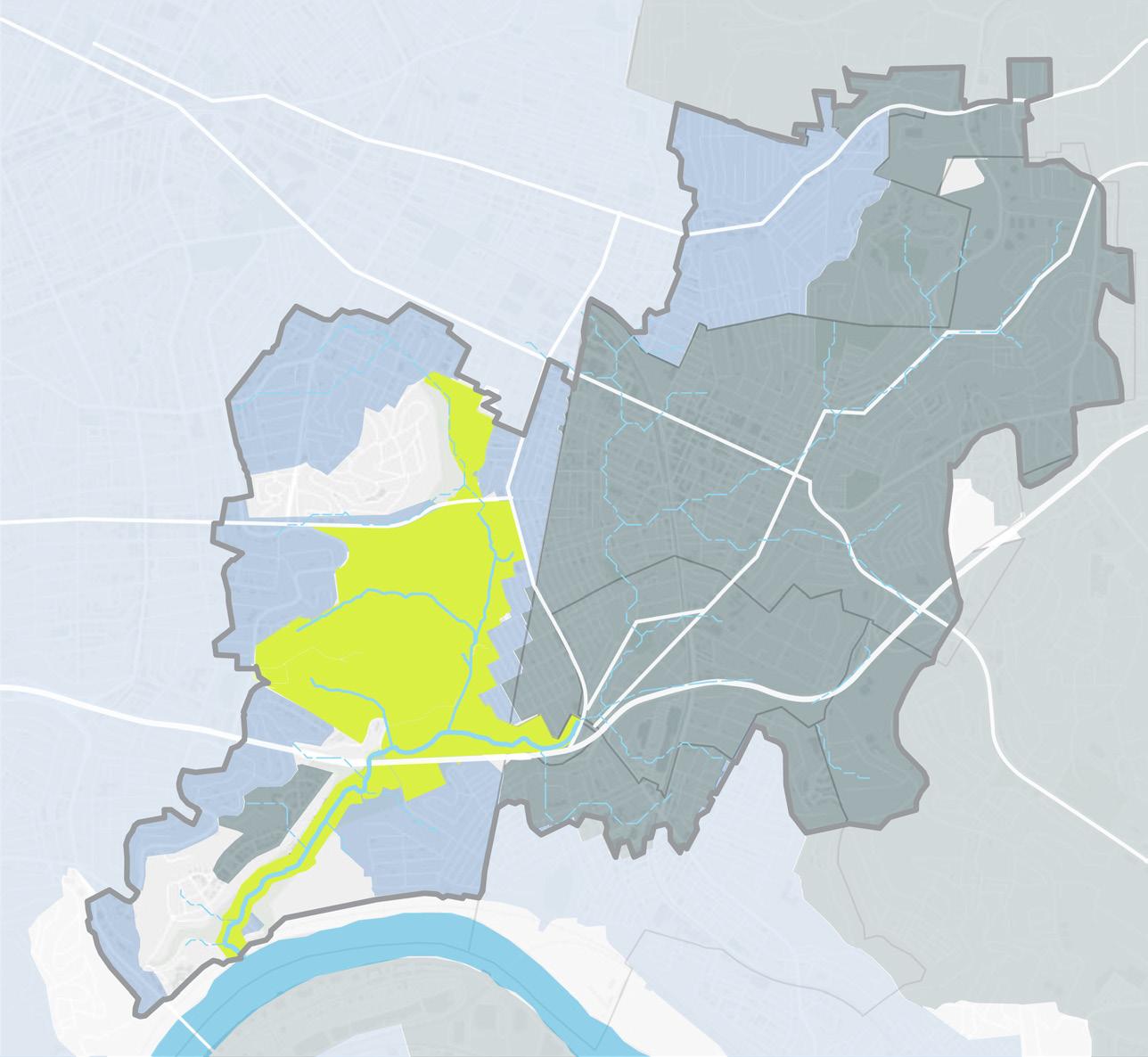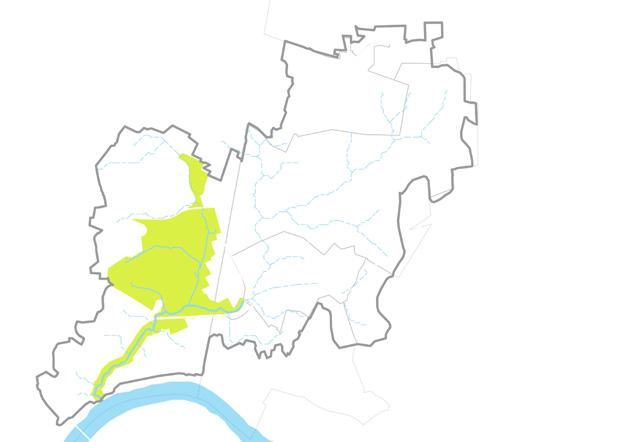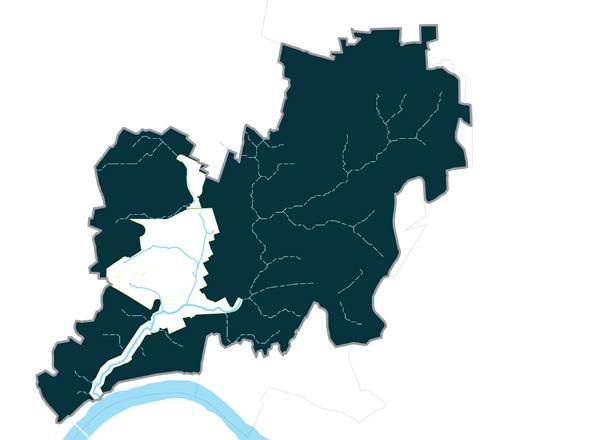
4 minute read
Our Geography
Sewershed Boundary
Frick Park
Advertisement
PITTSBURGH PENN HILLS

WILKINSBURG
EDGEWOOD
BRADDOCK HILLS SWISSVALE
Nine Mile Run (above ground) Nine Mile Run (below ground)
Sewershed Boundary
Combined Sewer Systems Municipal Separate Storm Sewer Systems (MS4s) Frick Park
Lower Shed: Frick Park The area in Frick Park where the stream is above ground and where the restoration work occurred. This is the lowest point in the sewershed and watershed. All water in the shed eventually flows through the lower shed and into the Monongahela River.


Upper Shed: Municipalities The entire sewershed and watershed area above the lower shed that collects the stormwater and combined sewage that flows into the lower shed of Nine Mile Run. Everything that happens here impacts the lower shed and the stream.

We are fundamentally a place-based organization. An understanding of our sewershed is critical to understanding the strategy of the organization. The Nine Mile Run restoration area sits in Frick Park, at the bottom of the Nine Mile Run watershed and sewershed. Our shed is divided among several municipalities - principally Pittsburgh, Wilkinsburg, Swissvale and Edgewood. It is also fed by two different kinds of sewer systems - combined (where stormwater and sanitary sewage flow in the same pipe) and municipal separate storm sewer systems (MS4s) (where there are separate pipes for stormwater and sanitary sewage). The primary source of sewage entering the Nine Mile Run stream is the combined sewer system in Pittsburgh. However, since much of the watershed has separated storm sewers (the MS4 communities), heavy rains carry any trash and other pollutants on the streets into the storm sewers and directly into Nine Mile Run. During major rain events, the stream spreads out across the floodplain, which is exactly what was intended in the re-design of the stream when it was restored between 2003 and 2006. But the more frequent and more intense storms we have experienced over the last few years due to climate change have carried more trash, and deposited it over a wider area, than ever before, damaging the restoration area, increasing maintenance costs and requiring costly repairs. The best way to protect the restoration area and the lower watershed is to work in the upper shed to reduce the amount of stormwater runoff reaching Nine Mile Run. The most effective way to do this is to use GSI to store and remove stormwater in the separated portions of the shed (the MS4 communities of Wilkinsburg, Swissvale and Edgewood) to attenuate flows that are overwhelming the stream, and in the combined sewer portions of the shed to reduce sewer overflows.
The Oakwood Batavia project in Homewood removes on average 1 million gallons of stormwater from the combined sewer every year, keeping sewage out of Nine Mile Run. (Board member and advocate Zinna Scott.)
Outside the Shed The area outside of the Nine Mile Run sewershed. This area does not directly impact Nine Mile Run, but these communities suffer from similar problems to Nine Mile Run and can benefit from the solutions we have developed in our shed.

Nine Mile Run is impacted by combined sewer systems, primarily in Pittsburgh to West and by Municipal Separate Storm Sewer Systems (MS4s) primarily to the East. These two types of systems impact the stream in different ways. ALCOSAN’s planned plant and gray infrastructure improvements will address some, but not all, of these impacts. Green infrastructure will solve problems that gray infrastructure cannot, particularly in the MS4 communities of the upper shed. What’s Going Into Nine Mile Run
Combined Sewer System Stormwater and sanitary sewage flow in the same pipe system to the treatment plant, but sometimes overflow to Nine Mile Run.
In dry weather, sewage is diverted to the treatment plant.
In wet weather, rain mixing with sewage overwhelms the pipe and combined sewage flows into Nine Mile Run. This is the main way sewage gets into the stream.
ALCOSAN’s planned investments in plant capacity and gray infrastructure under the Consent Decree will help to reduce combined sewer overflows.
Green infrastructure captures stormwater before it enters the system and can help reduce combined sewer overflows, helping to keep sewage out of the stream.
Combined Sewer
Combined Sewer System
LEGEND Sanitary/separated sewers Stormwater/combined sewers Stormwater sewers Green Infrastructure
Proposed deep storage tunnels (gray infrastructure) Sanitary sewer overflow (SSO) Combined sewer overflow (CSO) Stormwater sewer discharge
ALCOSAN interceptor pipes
6 Stormwater entering the sanitary sewer Sanitary sewage entering the storm sewer
Municipal Separate Storm Sewer System (MS4) Separate pipe systems carry stormwater directly to Nine Mile Run and sanitary sewage to the treatment plant.
Rainwater always flows directly to the stream without treatment. These flows overwhelm the stream restoration area with large volumes of water carrying trash and polluted runoff from roadways & parking lots. ALCOSAN’s planned gray infrastructure investments will not address this problem. Climate change will continue to make this problem worse.
Some sanitary sewage can get into the storm system from improperly connected sanitary lines. Municipalities are working to eliminate these sources.
Green infrastructure captures stormwater before it enters the system and can help reduce the volume of storm water reaching the stream.
Storm Sewer
Parallel Storm & Sanitary Sewer Systems
During major rain events, even sanitary sewers can overflow into Nine Mile Run.
Some stormwater gets into the sanitary system from improperly connected drains and downspouts or ground water infiltrating through old, cracked pipes. Municipalities are working to eliminate these sources, which will reduce sanitary sewer overflows (SSOs).
Sanitary sewage is diverted to the treatment plant in dry weather and small rain events. ALCOSAN’s planned investment in gray infrastructure will help reduce SSOs.
Sanitary Sewer



